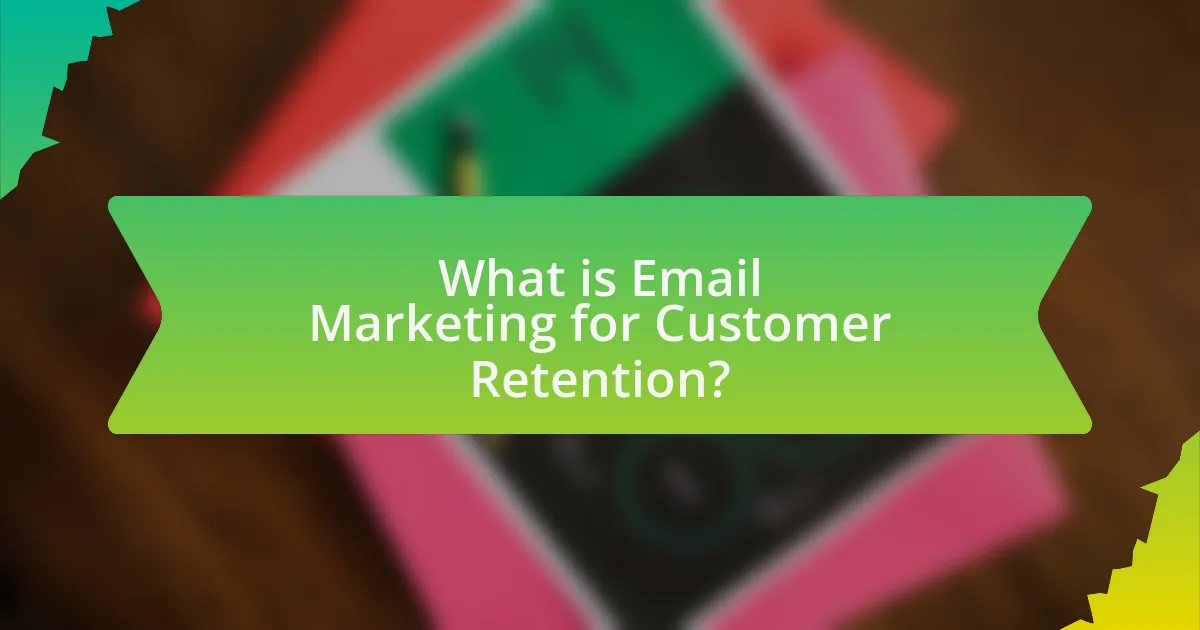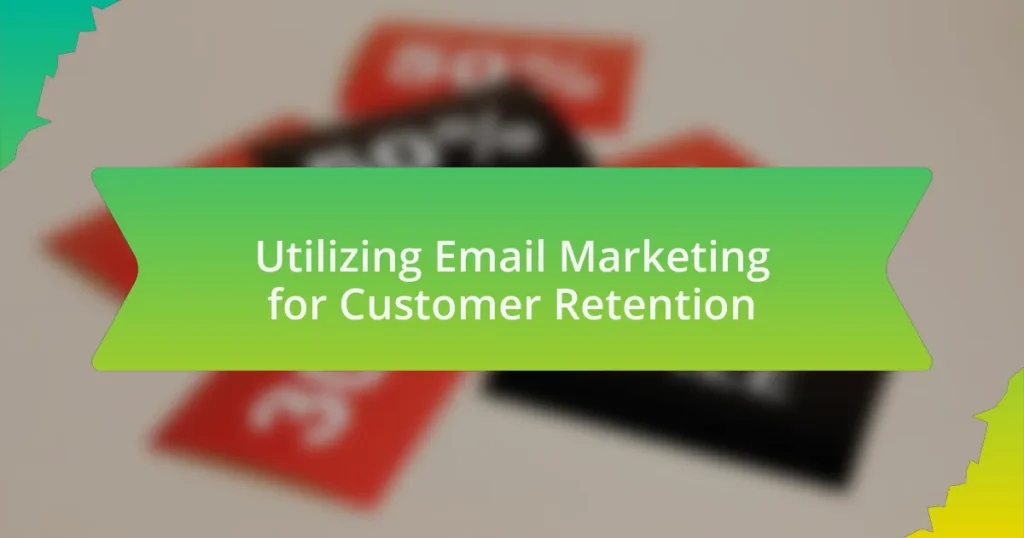Email marketing for customer retention is a strategic approach that leverages targeted communications to engage existing customers and promote repeat purchases. This article outlines how personalized content, segmentation, and automated follow-ups enhance customer loyalty and retention rates. It highlights the financial benefits of retaining customers through email marketing, including reduced acquisition costs and increased customer lifetime value. Additionally, the article discusses best practices for effective email campaigns, the importance of monitoring key metrics, and strategies to overcome common challenges in email marketing, ultimately emphasizing the significance of maintaining strong customer relationships for long-term business success.

What is Email Marketing for Customer Retention?
Email marketing for customer retention is a strategic approach that uses targeted email communications to engage existing customers and encourage repeat purchases. This method focuses on building relationships through personalized content, special offers, and relevant updates, which can significantly enhance customer loyalty. According to a study by the Direct Marketing Association, email marketing has an average return on investment of $42 for every dollar spent, highlighting its effectiveness in retaining customers.
How does Email Marketing contribute to Customer Retention?
Email marketing significantly contributes to customer retention by fostering direct communication and personalized engagement with customers. This approach allows businesses to send targeted messages, promotions, and updates that resonate with individual customer preferences, thereby enhancing their overall experience. According to a study by the Direct Marketing Association, email marketing has an average return on investment of $42 for every dollar spent, indicating its effectiveness in maintaining customer relationships. Additionally, personalized emails can increase transaction rates by up to six times, as reported by Experian, demonstrating that tailored content keeps customers engaged and encourages repeat purchases.
What are the key strategies in Email Marketing for retaining customers?
Key strategies in email marketing for retaining customers include personalized content, segmentation, and automated follow-ups. Personalized content enhances engagement by addressing customers by name and tailoring messages based on their preferences or past purchases. Segmentation allows marketers to categorize their audience into specific groups, enabling targeted campaigns that resonate with each segment’s unique interests. Automated follow-ups, such as cart abandonment emails or re-engagement campaigns, ensure timely communication that encourages customers to return. According to a study by Experian, personalized emails deliver six times higher transaction rates, demonstrating the effectiveness of these strategies in retaining customers.
How does personalization enhance Email Marketing effectiveness?
Personalization enhances email marketing effectiveness by increasing engagement rates and improving customer retention. When emails are tailored to individual preferences, behaviors, and demographics, recipients are more likely to open, read, and respond to them. According to a study by Experian, personalized emails deliver six times higher transaction rates compared to non-personalized emails. This demonstrates that targeted content resonates more with consumers, leading to higher conversion rates and fostering long-term customer loyalty.
Why is Customer Retention important for businesses?
Customer retention is crucial for businesses because it significantly reduces costs associated with acquiring new customers. Retaining existing customers is typically five to 25 times cheaper than attracting new ones, according to research by Bain & Company. Additionally, loyal customers tend to spend more over time, with studies indicating that increasing customer retention rates by just 5% can lead to a profit increase of 25% to 95%. This highlights the financial benefits of focusing on customer retention strategies, such as email marketing, which can effectively engage and nurture existing customers.
What are the financial benefits of retaining customers through Email Marketing?
Retaining customers through email marketing significantly enhances financial performance by increasing customer lifetime value. Research indicates that acquiring a new customer can cost five times more than retaining an existing one, highlighting the cost-effectiveness of email marketing strategies aimed at existing customers. Additionally, loyal customers generated through effective email campaigns tend to spend 67% more than new customers, according to a study by Bain & Company. This demonstrates that email marketing not only fosters customer loyalty but also drives higher revenue per customer, ultimately leading to improved profitability for businesses.
How does Customer Retention impact brand loyalty?
Customer retention significantly enhances brand loyalty by fostering a deeper emotional connection between customers and the brand. When customers repeatedly choose a brand, they develop trust and familiarity, which are critical components of loyalty. Research indicates that increasing customer retention rates by just 5% can lead to an increase in profits of 25% to 95%, highlighting the financial benefits of maintaining loyal customers. Additionally, loyal customers are more likely to recommend the brand to others, further solidifying its market position. This cycle of retention and loyalty creates a stable customer base that is essential for long-term business success.

What are the Best Practices for Email Marketing in Customer Retention?
The best practices for email marketing in customer retention include personalizing content, segmenting your audience, optimizing send times, and providing valuable offers. Personalization increases engagement; studies show that personalized emails have a 29% higher open rate. Segmenting your audience allows for targeted messaging, which can lead to a 760% increase in revenue. Optimizing send times based on customer behavior can enhance open rates, with research indicating that emails sent on Tuesdays and Thursdays perform best. Lastly, providing valuable offers, such as exclusive discounts or loyalty rewards, encourages repeat purchases and strengthens customer loyalty.
How can segmentation improve Email Marketing outcomes?
Segmentation can significantly improve email marketing outcomes by allowing marketers to tailor their messages to specific audience groups, resulting in higher engagement rates. When emails are personalized based on customer demographics, behaviors, or preferences, recipients are more likely to open, click, and convert. For instance, according to a study by Mailchimp, segmented campaigns have an average open rate of 14.32% compared to 11.4% for non-segmented campaigns, demonstrating the effectiveness of targeted messaging. This targeted approach not only enhances customer satisfaction but also increases the likelihood of repeat purchases, thereby improving overall customer retention.
What criteria should be used for effective segmentation?
Effective segmentation should utilize criteria such as demographics, psychographics, behavior, and geographic location. Demographics include age, gender, income, and education level, which help identify target audiences. Psychographics focus on lifestyle, values, and interests, allowing marketers to tailor messages that resonate with specific customer motivations. Behavioral criteria analyze past purchase behavior, engagement levels, and customer loyalty, providing insights into how customers interact with the brand. Geographic segmentation considers the physical location of customers, which can influence preferences and buying habits. These criteria collectively enhance the precision of targeting efforts, leading to improved customer retention rates through personalized email marketing strategies.
How does segmentation influence customer engagement?
Segmentation significantly enhances customer engagement by allowing businesses to tailor their marketing messages to specific groups based on shared characteristics. This targeted approach increases the relevance of communications, leading to higher open and click-through rates. For instance, according to a study by Mailchimp, segmented email campaigns have an average open rate of 14.32%, compared to 11.4% for non-segmented campaigns. By delivering personalized content that resonates with individual preferences and behaviors, segmentation fosters a stronger connection between the brand and the customer, ultimately driving engagement and retention.
What types of email campaigns are most effective for retention?
Personalized email campaigns are the most effective for retention. These campaigns leverage customer data to tailor content, recommendations, and offers to individual preferences and behaviors. Research indicates that personalized emails can deliver six times higher transaction rates compared to non-personalized emails, highlighting their effectiveness in engaging customers and encouraging repeat purchases. Additionally, loyalty program emails that reward customers for their continued engagement have shown to significantly increase retention rates, as they create a sense of value and appreciation among customers.
How do welcome emails contribute to customer retention?
Welcome emails significantly enhance customer retention by establishing a positive first impression and fostering engagement. These emails typically contain personalized content, which can increase customer satisfaction and loyalty. Research indicates that welcome emails have an average open rate of 50%, compared to standard emails, which hover around 20%. This higher engagement leads to a greater likelihood of customers returning to the brand. Additionally, welcome emails often include incentives, such as discounts or exclusive offers, which can further encourage repeat purchases and strengthen the customer relationship.
What role do re-engagement campaigns play in retaining customers?
Re-engagement campaigns play a crucial role in retaining customers by rekindling interest and encouraging inactive users to return. These campaigns typically utilize targeted email marketing strategies to remind customers of the value of a brand, often offering incentives or personalized content to re-establish a connection. Research indicates that re-engagement emails can achieve open rates as high as 30%, significantly higher than standard promotional emails, demonstrating their effectiveness in capturing attention and driving action. By addressing the specific needs and preferences of previously engaged customers, re-engagement campaigns can effectively reduce churn rates and enhance overall customer loyalty.

What Metrics Should be Monitored in Email Marketing for Customer Retention?
The key metrics to monitor in email marketing for customer retention include open rates, click-through rates, conversion rates, unsubscribe rates, and customer lifetime value. Open rates indicate the percentage of recipients who open emails, reflecting the effectiveness of subject lines and sender reputation. Click-through rates measure the percentage of recipients who click on links within emails, showcasing engagement levels. Conversion rates track the percentage of email recipients who complete a desired action, such as making a purchase, which directly correlates with retention efforts. Unsubscribe rates reveal the percentage of recipients opting out, providing insight into content relevance and customer satisfaction. Lastly, customer lifetime value quantifies the total revenue a customer generates throughout their relationship with a brand, emphasizing the importance of retaining customers through effective email strategies. Monitoring these metrics allows businesses to refine their email marketing tactics and enhance customer retention.
How can open rates indicate the effectiveness of retention strategies?
Open rates serve as a key metric to gauge the effectiveness of retention strategies by reflecting customer engagement with email communications. High open rates indicate that customers are interested in the content being delivered, suggesting that retention strategies are resonating with the audience. For instance, a study by Mailchimp found that the average open rate for email campaigns across industries is around 21.33%, and campaigns focused on customer retention often achieve higher rates, demonstrating successful engagement. Conversely, low open rates may signal that retention efforts are failing to capture customer attention, prompting a reevaluation of content relevance and delivery timing. Thus, analyzing open rates provides actionable insights into the success of retention strategies in maintaining customer interest and loyalty.
What factors influence open rates in retention emails?
The factors that influence open rates in retention emails include subject line effectiveness, sender reputation, timing of the email, and personalization. Subject lines that are concise, engaging, and relevant can significantly increase open rates; studies show that emails with personalized subject lines have a 26% higher open rate. Sender reputation, which is determined by previous engagement and deliverability, also plays a crucial role; emails from trusted senders are more likely to be opened. Timing affects open rates as well; emails sent during optimal hours, typically mid-morning or early afternoon, tend to perform better. Lastly, personalization, such as addressing the recipient by name or tailoring content to their preferences, enhances engagement and can lead to higher open rates.
How can A/B testing improve open rates?
A/B testing can improve open rates by allowing marketers to compare different email elements, such as subject lines or send times, to determine which version resonates more with the audience. By systematically testing variations, marketers can identify the most effective strategies that lead to higher engagement. For instance, a study by Campaign Monitor found that personalized subject lines can increase open rates by 26%. This data-driven approach enables marketers to refine their email campaigns based on actual performance metrics, ultimately leading to improved open rates and better customer retention.
What are the common challenges in Email Marketing for Customer Retention?
Common challenges in email marketing for customer retention include low open rates, high unsubscribe rates, and ineffective segmentation. Low open rates hinder engagement, as only about 20% of marketing emails are opened on average, according to a 2023 report by Mailchimp. High unsubscribe rates can indicate that content is not resonating with the audience, leading to a loss of potential repeat customers. Ineffective segmentation results in irrelevant messaging, which can diminish customer interest and loyalty. These challenges collectively impact the effectiveness of email marketing strategies aimed at retaining customers.
How can businesses overcome low engagement rates?
Businesses can overcome low engagement rates by personalizing their email marketing campaigns. Personalization increases open rates by 26% and click-through rates by 14%, as shown in a study by Experian. By segmenting their audience based on behavior, preferences, and demographics, businesses can tailor content that resonates with specific groups, leading to higher engagement. Additionally, optimizing send times and using compelling subject lines can further enhance engagement, as research indicates that emails sent at optimal times can increase open rates significantly.
What strategies can be implemented to avoid email fatigue?
To avoid email fatigue, businesses should implement strategies such as segmenting their email lists, personalizing content, and optimizing sending frequency. Segmenting allows for targeted messaging, ensuring that recipients receive relevant information, which can increase engagement rates. Personalization enhances the user experience by addressing individual preferences and behaviors, making emails feel more tailored and less generic. Research indicates that personalized emails can lead to a 29% higher open rate and a 41% higher click-through rate. Additionally, optimizing sending frequency helps prevent overwhelming recipients; studies show that sending too many emails can lead to higher unsubscribe rates. By balancing these strategies, businesses can maintain customer interest and improve retention through effective email marketing.
What are the key takeaways for successful Email Marketing in Customer Retention?
Successful email marketing for customer retention hinges on personalization, segmentation, and consistent engagement. Personalization increases open rates by 26%, as tailored content resonates more with recipients. Segmentation allows businesses to target specific customer groups, leading to higher conversion rates; for instance, segmented campaigns can yield up to 760% more revenue than non-segmented ones. Consistent engagement through regular newsletters and updates keeps the brand top-of-mind, fostering loyalty. Additionally, utilizing automated follow-ups for abandoned carts can recover up to 15% of lost sales, demonstrating the effectiveness of timely communication.


